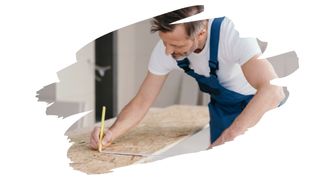OSB is a popular building material, mostly used for sub-flooring, and wall sheathing.
But, when it comes to indoor furniture and shelving, is this material safe to have around the place?
Well, in this post, you will learn what chemicals really go into the manufacture of OSB. You’ll also learn whether OSB is really that toxic, or if it is safe enough to have in your home.
And keep reading to find out if OSB is actually suitable for making bathroom sub-flooring.

This post may contain affiliate links to products that we receive a commission for (at no additional cost to you). Learn more here.
What Is OSB Made Of Exactly?
OSB is a manufactured wood, which means it is a composite material made from thin wood strands. And all of those wooden strands are packed into this material and bound together using a strong glue.
Now, there are many different types of wood glues out there, that you might already have heard of. But, the glue in OSB is nothing like the PVA (Polyvinyl Acetate) wood glues you may be familiar with.
Instead, the glue used inside OSB is made from formaldehyde resins such as Melamine-Urea-Formaldehyde (MUF) or Phenol Formaldehyde (PF).
Does OSB Actually Have Formaldehyde In It?
The glues used to make OSB certainly do, which is why OSB is far and away from being a natural material.
What’s more, formaldehyde is dangerous stuff. If it is inhaled, ingested, or if it gets on your skin, it can be very painful (at best). And formaldehyde is at it’s most dangerous when it is a vapor.
So, when formaldehyde-resin glue is off-gassing, it is toxic to be around.
And What Is Off Gassing?
Well, off gassing refers to the fumes released from solvents, paints, and glues as they dry. Those fumes, (technically referred to as Volatile Organic Compounds or ‘VOC’s’), can hang around for a good long while.
If you’ve ever painted a room, you’ve probably already smelled the effects of this. While paint may take a few hours to dry to the touch, it can take weeks, (even months), for paint fumes to dissipate.
And the same goes for formaldehyde-resin glues as well.
Does That Mean That OSB Can Make You Sick (Because Of Those Toxic Fumes)?
Freshly manufactured OSB certainly can, since it will still be off-gassing a fair bit. Particularly as Phenol Formaldehyde glues can off-gas for months on end.
However, when you buy OSB from the store, it’ll have already likely been sat in the store for a while. And before that, it would have been drying out in the place it was manufactured.
So, when it comes to ‘aged’ store-bought OSB, most (if not all of) the off-gassing fumes should have dissipated. Which means, by the time you buy it, OSB should have little impact on the air-quality of your home.
Is OSB More Toxic Than Plywood?
It is not more toxic than plywood. However, OSB can pose a health-risk for longer than plywood, due to it’s thickness.
You see, plywood and OSB both use formaldehyde-resin glues to bind them together. So, the glues used in plywood are pretty much made from the same stuff used in OSB.
But, OSB is a much more dense material than plywood.
Now, on one hand, OSB’s density advantage means that it has a lot more shear strength than plywood. In fact, OSB has nearly twice the shear strength of plywood.
But, on the other hand, this means OSB contains more formaldehyde-resin glue in it, compared to plywood. And all of that extra glue means that OSB will take longer to finish off-gassing.
Related Post: Why You Should Use OSB (Not Plywood) For Your Attic Floor
OK, Got It. Can You Still Use OSB For Bathroom Sub-Flooring?
Generally, it’s a bad idea to use OSB in a steam-filled bathroom, due to it’s poor water-resistance. On top of that, OSB isn’t the best weight-bearing material you can use either.
While OSB may have twice the shear strength of plywood, it’s compressional strength pales in comparison to plywood.
And when it comes to weight-bearing floors, compressional strength matters a lot more.
You can discover more about the contrasting strengths of these two manufactured woods in our post here: OSB vs Plywood For Your Shelves: 3 Key Things You Need To Consider.
What’s more, OSB isn’t the best material to use in areas of high humidity and moisture.
You see, OSB may take a while to absorb water, but once water gets in it, it will take forever to dry out. Which is why OSB can tend to rot if it is used for outdoor structures.
Now, there are some moisture-resistant OSB sheets you can buy, such as OSB/3 and OSB/4 graded material. But, they are very, very expensive. And they are better used for siding — than flooring — anyway.
So, OSB tends to primarily be used more for things like attic flooring and sheathing, rather than for furniture or shelving.
In other words, think of OSB as being more of a material you would use to help construct your home. But, it’s not the go-to material for making furniture and other items inside your home.
You can learn more about OSB and it’s water-resistance (or lack thereof) in our post here: Can OSB Board Really Get Wet? (7 Things You Need To Know)
So Is OSB Safe To Use Indoors?
Yes it is, provided that it is shop-dry and no longer off-gassing. However, if it gets wet and starts to mold, there are health risks associated with rotting OSB materials.
And, when working with OSB, make sure you avoid inhaling any of the dust created by machining it. That’s because it’s dust carries significant health risks if it’s inhaled.
What Is ‘Shop-Dry’ Wood? This refers to wood, (or composite wooden materials), that have been sat in the back of a shop for a while. Whilst there, they’ll have had time to dry-out.
To Wrap Up, Here Are The 3 Key Takeaways From This Post…
- 1). OSB is a manufactured wood made from thin wood strands. Those strands are then held together using formaldehyde-resin glues.
- 2). OSB is safe to use indoors, provided that it is no longer off-gassing.
- 3). OSB is a construction material typically used for sheathing and siding. It is not the best material for making flooring or furniture.
References:
Simple and accurate temperature correction for moisture pin calibrations in oriented strand board (fs.fed.us)
Phenol Formaldehyde | ScienceDirect.com
Choosing Between Oriented Strandboard And Plywood | University of Massachusetts Amherst



